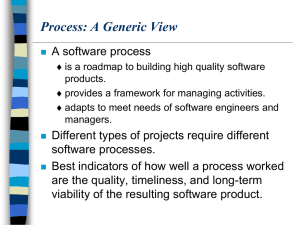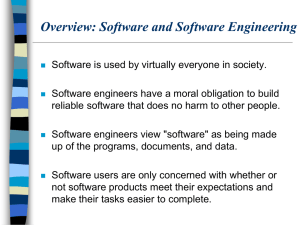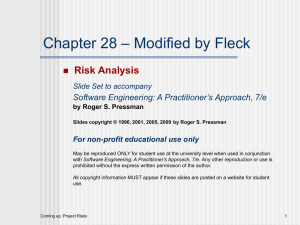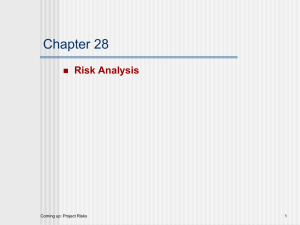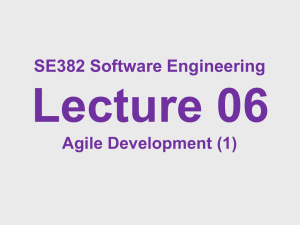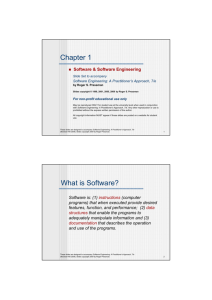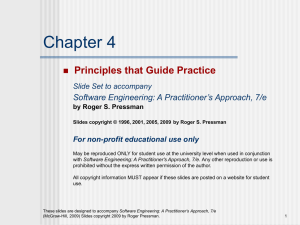Slide Set to accompany Web Engineering: A Practitioner Approach
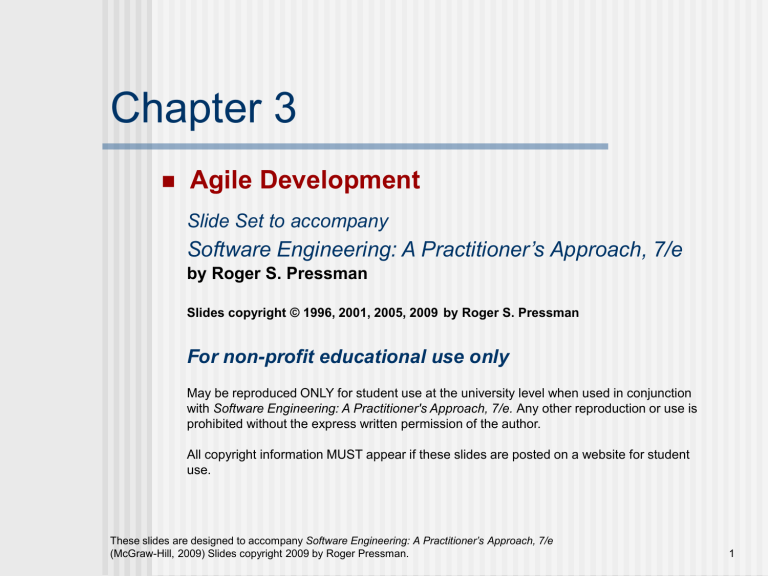
Chapter 3
Agile Development
Slide Set to accompany
Software Engineering: A Practitioner’s Approach, 7/e by Roger S. Pressman
Slides copyright © 1996, 2001, 2005, 2009 by Roger S. Pressman
For non-profit educational use only
May be reproduced ONLY for student use at the university level when used in conjunction with Software Engineering: A Practitioner's Approach, 7/e. Any other reproduction or use is prohibited without the express written permission of the author.
All copyright information MUST appear if these slides are posted on a website for student use.
These slides are designed to accompany Software Engineering: A Practitioner’s Approach, 7/e
(McGraw-Hill, 2009) Slides copyright 2009 by Roger Pressman. 1
The Manifesto for
Agile Software Development
“We are uncovering better ways of developing software by doing it and helping others do it.
Through this work we have come to value:
• Individuals and interactions over processes and tools
• Working software over comprehensive documentation
• Customer collaboration over contract negotiation
• Responding to change over following a plan
That is, while there is value in the items on the right, we value the items on the left more.”
Kent Beck et al
These slides are designed to accompany Software Engineering: A Practitioner’s Approach, 7/e
(McGraw-Hill, 2009) Slides copyright 2009 by Roger Pressman. 2
What is “Agility”?
Effective (rapid and adaptive) response to change
Effective communication among all stakeholders
Drawing the customer onto the team
Organizing a team so that it is in control of the work performed
Yielding …
Rapid, incremental delivery of software
These slides are designed to accompany Software Engineering: A Practitioner’s Approach, 7/e
(McGraw-Hill, 2009) Slides copyright 2009 by Roger Pressman. 3
Agility
An agile team is able to respond to changes during project development
Agile development recognizes that project plans must be flexible
Agility encourages team structures and attitudes that make communication among developers and customers more facile (easily done)
Eliminates the separation between customers and developers
These slides are designed to accompany Software Engineering: A Practitioner’s Approach, 7/e
(McGraw-Hill, 2009) Slides copyright 2009 by Roger Pressman. 4
Agility
Agility emphasizes the importance of rapid delivery of operational software and de-emphasizes importance of intermediate work products
Agility can be applied to any software process as long as the project team is allowed to streamline tasks and conduct planning in way that eliminate non-essential work products
The costs of change increase rapidly as a project proceeds to completion, the earlier a change is made the less costly it will be
Agile processes may flatten the cost of change curve by allowing a project team to make changes late in the project at much lower costs
These slides are designed to accompany Software Engineering: A Practitioner’s Approach, 7/e
(McGraw-Hill, 2009) Slides copyright 2009 by Roger Pressman. 5
Agility and the Cost of Change
These slides are designed to accompany Software Engineering: A Practitioner’s Approach, 7/e
(McGraw-Hill, 2009) Slides copyright 2009 by Roger Pressman. 6
An Agile Process
Are based on three key assumptions
1.
2.
3.
It is difficult to predict in advance which requirements or customer priorities will change and which will not
For many types of software design and construction activities are interleaved (construction is used to prove the design)
Analysis, design, and testing are not as predictable (from a planning perspective) as one might like them to be
Agile processes must be adapt incrementally to manage unpredictability
Incremental adaptation requires customer feedback based on evaluation of delivered software increments (executable prototypes) over short time periods
These slides are designed to accompany Software Engineering: A Practitioner’s Approach, 7/e
(McGraw-Hill, 2009) Slides copyright 2009 by Roger Pressman. 7
Agility Principles - I
1. Our highest priority is to satisfy the customer through early and continuous delivery of valuable software.
2. Welcome changing requirements, even late in development.
Agile processes harness change for the customer's competitive advantage.
3. Deliver working software frequently, from a couple of weeks to a couple of months, with a preference to the shorter timescale.
4. Business people and developers must work together daily throughout the project.
5. Build projects around motivated individuals. Give them the environment and support they need, and trust them to get the job done.
6. The most efficient and effective method of conveying information to and within a development team is face –to–face conversation.
These slides are designed to accompany Software Engineering: A Practitioner’s Approach, 7/e
(McGraw-Hill, 2009) Slides copyright 2009 by Roger Pressman. 8
Agility Principles - II
7. Working software is the primary measure of progress.
8. Agile processes promote sustainable development. The sponsors, developers, and users should be able to maintain a constant pace indefinitely.
9. Continuous attention to technical excellence and good design enhances agility.
10. Simplicity
11. The best architectures, requirements, and designs emerge from self –organizing teams.
12. At regular intervals, the team reflects on how to become more effective, then tunes and adjusts its behavior accordingly.
These slides are designed to accompany Software Engineering: A Practitioner’s Approach, 7/e
(McGraw-Hill, 2009) Slides copyright 2009 by Roger Pressman. 9
Human Factors
the process molds to the needs of the people and team, not the other way around key traits must exist among the people on an agile team and the team itself:
Competence ( proficiency ).
Common focus.
Collaboration.
Decision-making ability.
Fuzzy problem-solving ability.
Mutual trust and respect.
Self-organization.
These slides are designed to accompany Software Engineering: A Practitioner’s Approach, 7/e
(McGraw-Hill, 2009) Slides copyright 2009 by Roger Pressman. 10
Extreme Programming (XP)
The most widely used agile process, originally proposed by Kent Beck
XP Planning
Begins with the creation of “ user stories ”
Agile team assesses each story and assigns a cost
Stories are grouped to for a deliverable increment
A commitment is made on delivery date
After the first increment “ project velocity ” is used to help define subsequent delivery dates for other increments
These slides are designed to accompany Software Engineering: A Practitioner’s Approach, 7/e
(McGraw-Hill, 2009) Slides copyright 2009 by Roger Pressman. 11
Extreme Programming (XP)
XP Design
Follows the KIS principle
Encourage the use of CRC cards (see 6.5.4)
For difficult design problems, suggests the creation of “ spike solutions
”—a design prototype
Encourages “ refactoring ”—an iterative refinement of the internal program design
XP Coding
Recommends the construction of a unit test for a store before coding commences
Encourages “ pair programming ”
XP Testing
All unit tests are executed daily
“Acceptance tests” are defined by the customer and executed to assess customer visible functionality
These slides are designed to accompany Software Engineering: A Practitioner’s Approach, 7/e
(McGraw-Hill, 2009) Slides copyright 2009 by Roger Pressman. 12
Extreme Programming (XP)
simple design
CRC cards spike solut ions prot ot ypes user st ories values
accept ance t est crit eria it erat ion plan ref act oring pair programming
Release sof t ware increment project velocit y comput ed unit t est cont inuous int egrat ion accept ance t est ing
These slides are designed to accompany Software Engineering: A Practitioner’s Approach, 7/e
(McGraw-Hill, 2009) Slides copyright 2009 by Roger Pressman. 13
Adaptive Software Development
Originally proposed by Jim Highsmith
Self-organization arises when independent agents cooperate to create a solution to a problem that is beyond the capability of any individual agent
Emphasizes self-organizing teams, interpersonal collaboration, and both individual and team learning
These slides are designed to accompany Software Engineering: A Practitioner’s Approach, 7/e
(McGraw-Hill, 2009) Slides copyright 2009 by Roger Pressman. 14
Phases
Speculation (project initiated and adaptive cycle planning takes place)
Collaboration (requires teamwork from a jelled team, joint application development is preferred requirements gathering approach)
Learning (components implemented and testes, focus groups provide feedback, formal technical reviews, postmortems)
These slides are designed to accompany Software Engineering: A Practitioner’s Approach, 7/e
(McGraw-Hill, 2009) Slides copyright 2009 by Roger Pressman. 15
Adaptive Software Development
adapt ive cycle planning uses mission st at ement
project const raint s
basic requirement s t ime-boxed release plan
Requirement s gat hering
JAD
mini-specs
Release sof t ware increment adjust ment s f or subsequent cycles component s implement ed/ t est ed f ocus groups f or f eedback
f ormal t echnical reviews post mort ems
These slides are designed to accompany Software Engineering: A Practitioner’s Approach, 7/e
(McGraw-Hill, 2009) Slides copyright 2009 by Roger Pressman. 16
Scrum
Originally proposed by Schwaber and Beedle
Scrum —distinguishing features
Development work is partitioned into “ packets ”
Testing and documentation are on-going as the product is constructed
Work occurs in “ sprints ” and is derived from a
“ backlog ” of existing requirements
Meetings are very short and sometimes conducted without chairs
“ demos ” are delivered to the customer with the timebox allocated
These slides are designed to accompany Software Engineering: A Practitioner’s Approach, 7/e
(McGraw-Hill, 2009) Slides copyright 2009 by Roger Pressman. 17
Scrum principles
Small working team used to maximize communication, minimize overhead, and maximize sharing of informal knowledge
Process must be adaptable to both technical and business challenges to ensure best product produced
Process yields frequent increments that can be inspected, adjusted, tested, documented and built on
Development work and people performing it are partitioned into clean, low coupling partitions
Testing and documentation is performed as the product is built
Provides the ability to declare the product done whenever required
These slides are designed to accompany Software Engineering: A Practitioner’s Approach, 7/e
(McGraw-Hill, 2009) Slides copyright 2009 by Roger Pressman. 18
Scrum
Scrum Process Flow (used wit h permission)
These slides are designed to accompany Software Engineering: A Practitioner’s Approach, 7/e
(McGraw-Hill, 2009) Slides copyright 2009 by Roger Pressman. 19
Dynamic Systems Development Method
Promoted by the DSDM Consortium ( www.dsdm.org
)
DSDM —distinguishing features
Similar in most respects to XP and/or ASD
Nine guiding principles
• Active user involvement is imperative.
•
DSDM teams must be empowered to make decisions.
• The focus is on frequent delivery of products.
• Fitness for business purpose is the essential criterion for acceptance of deliverables.
• Iterative and incremental development is necessary to converge on an accurate business solution.
• All changes during development are reversible.
•
Requirements are baselined at a high level
• Testing is integrated throughout the life-cycle.
These slides are designed to accompany Software Engineering: A Practitioner’s Approach, 7/e
(McGraw-Hill, 2009) Slides copyright 2009 by Roger Pressman. 20
Dynamic Systems Development Method
DSDM Life Cycle (with permission of the DSDM consortium)
These slides are designed to accompany Software Engineering: A Practitioner’s Approach, 7/e
(McGraw-Hill, 2009) Slides copyright 2009 by Roger Pressman. 21
Crystal
Proposed by Cockburn and Highsmith
Crystal —distinguishing features
Actually a family of process models that allow
“ maneuverability ” based on problem characteristics
Face-to-face communication is emphasized
Suggests the use of “ reflection workshops ” to review the work habits of the team
These slides are designed to accompany Software Engineering: A Practitioner’s Approach, 7/e
(McGraw-Hill, 2009) Slides copyright 2009 by Roger Pressman. 22
Feature Driven Development
Originally proposed by Peter Coad et al
FDD —distinguishing features
Emphasis is on defining “features”
• a feature “is a client-valued function that can be implemented in two weeks or less.”
Uses a feature template
• <action> the <result> <by | for | of | to> a(n) <object>
A features list is created and “ plan by feature ” is conducted
Design and construction merge in FDD
These slides are designed to accompany Software Engineering: A Practitioner’s Approach, 7/e
(McGraw-Hill, 2009) Slides copyright 2009 by Roger Pressman. 23
Feature Driven Development
Reprinted with permission of Peter Coad
These slides are designed to accompany Software Engineering: A Practitioner’s Approach, 7/e
(McGraw-Hill, 2009) Slides copyright 2009 by Roger Pressman. 24
Agile Modeling
Originally proposed by Scott Ambler
Suggests a set of agile modeling principles
Model with a purpose
Use multiple models
Travel light
Content is more important than representation
Know the models and the tools you use to create them
Adapt locally
These slides are designed to accompany Software Engineering: A Practitioner’s Approach, 7/e
(McGraw-Hill, 2009) Slides copyright 2009 by Roger Pressman. 25
